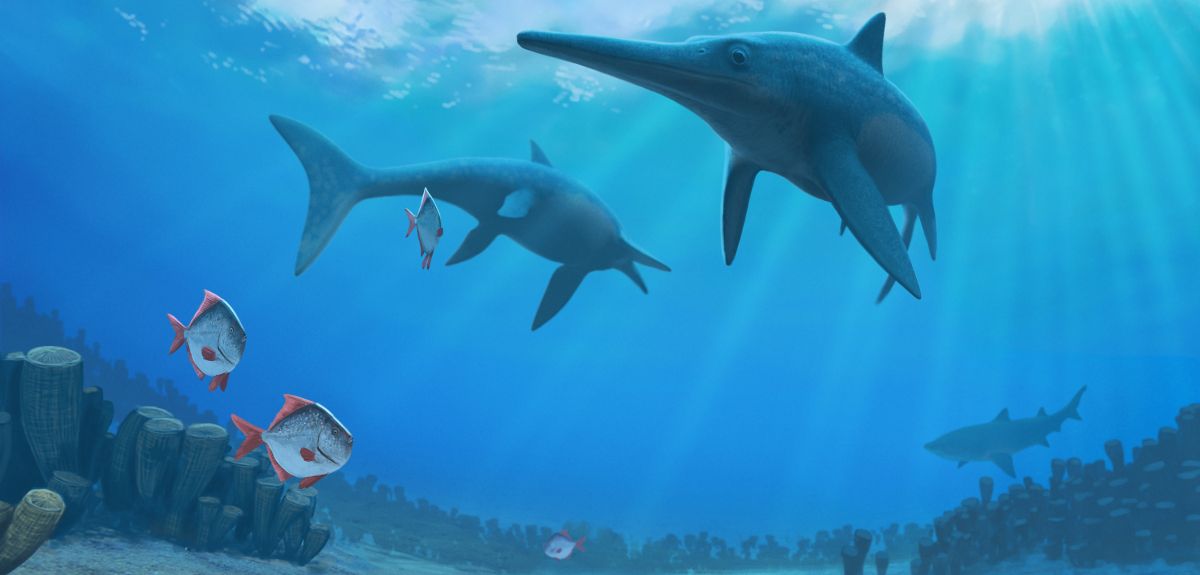
Image credit: Andrey Atuchin
Slower evolution and climate change drove ichthyosaurs to extinction
Ichthyosaurs – shark-like marine reptiles from the time of dinosaurs – were driven to extinction by intense climate change and their own failure to evolve quickly enough, according to new research by an international team of scientists.
The study provides an explanation for one of the longest-standing enigmas in palaeobiology: how and why ichthyosaurs died out. Unlike other marine reptile groups, ichthyosaurs disappeared tens of millions of years before the end-Cretaceous extinction (65 million years ago) that marked the end for dinosaurs and the beginning of the age of mammals.
The research is published in the journal Nature Communications.
First author Dr Valentin Fischer, of the University of Liège, Belgium, and the Department of Earth Sciences at the University of Oxford, UK, said: 'We analysed the extinction of this crucial marine group thoroughly for the first time. We compared the diversity of ichthyosaurs with the geological record of global change, emphasising the dynamics of these datasets.
'Ichthyosaurs were actually well diversified during the last chapter of their reign, with several species, body shapes and ecological niches present. However, their evolution was much slower than earlier in their history. Additionally, they were seemingly negatively affected by the profound global changes going on during the Cretaceous, as their extinction rate correlates with environmental volatility.'
Causes of extinctions – including the demise of the ichthyosaurs, or 'sea dragons' – have often remained elusive and conjectural, particularly when they cannot be linked to an obvious geological or geochemical event such as a large meteorite or massive volcanic eruption. Ichthyosaurs were regarded as undiversified for a prolonged period before their extinction, and their dying out has previously been linked to minor events including increased competition with other marine predators and a decline in their assumed principal source of food.
However, using a battery of cutting-edge techniques to quantify ancient biodiversity and its fluctuations, the team was able to reconstruct the evolution of the ichthyosaurs during the last 120 million years of their lifetime and assess the causes of their extinction. The researchers – comprising Belgian, British, French and Russian scientists – demonstrated that before their extinction, ichthyosaurs were in fact highly diverse, both in terms of body shape and ecological role.
A two-phase event then suppressed their ecological diversity and wiped out the group at the beginning of the Late Cretaceous period, about 100 million years ago. At that time, the Earth's poles were essentially ice-free, and sea levels were much higher than today. Analyses revealed that this two-phase extinction can be associated both with reduced evolutionary rates (a failure to evolve novel body plans for a prolonged period) and intense climate change (strong variations in sea surface temperatures and sea levels).
Dr Fischer added: 'Although the rising temperatures and sea levels evidenced in rock records throughout the world may not directly have affected ichthyosaurs, related factors such as changes in food availability, migratory routes, competitors and birthing places are all potential drivers, probably occurring in conjunction to drive ichthyosaurs to extinction.'
This new work supports a growing body of evidence suggesting that a major, global, change-driven turnover profoundly reorganised marine ecosystems at the beginning of the Late Cretaceous, giving rise to the highly peculiar and geologically brief Late Cretaceous marine world. Ichthyosaurs disappeared in the course of this turnover, while numerous lineages of bony fishes and sharks evolved. The extinction of ichthyosaurs thus appears to be one aspect of a larger event – something the team is currently investigating.
The study 'Extinction of fish-shaped marine reptiles associated with reduced evolutionary rates and global environmental volatility' is published in Nature Communications.
 New analysis of archaeological data reveals how agriculture and governance have shaped wealth inequality
New analysis of archaeological data reveals how agriculture and governance have shaped wealth inequality
 Cambridge victorious in Women's and Men's Boat Races 2025
Cambridge victorious in Women's and Men's Boat Races 2025
 Expert Comment: Ethical and legal challenges of uterus transplants in Mexico
Expert Comment: Ethical and legal challenges of uterus transplants in Mexico